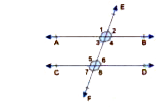Indicate which pairs of angles are:(i) Vertically opposite angles. (ii) Linear pairs.
To solve the question of identifying vertically opposite angles and linear pairs, we can follow these steps:
Step 1: Identify Vertically Opposite Angles
1. Definition: Vertically opposite angles are the angles that are opposite each other when two lines intersect. They are equal in measure.
2. Identification:
- Look at the angles formed by the intersection of two lines.
- For example, if we have angles labeled as 1, 2, 3, 4, and 5:
- Angle 1 and Angle 4 are vertically opposite.
- Angle 5 is vertically opposite to the sum of Angle 2 and Angle 3.
Step 2: Identify Linear Pairs
1. Definition: Linear pairs are two adjacent angles that form a straight line, meaning their measures add up to 180 degrees.
2. Identification:
- Check which angles are adjacent and lie on the same straight line.
- For example:
- Angle 1 and Angle 5 form a linear pair.
- Angles 2, 3, and 4 together also form linear pairs.
- Angle 1, Angle 2, and Angle 3 also form a linear pair.
- Angle 4 and Angle 5 form another linear pair.
Summary of Findings
- Vertically Opposite Angles:
- Angle 1 and Angle 4
- Angle 5 and the sum of Angle 2 and Angle 3
- Linear Pairs:
- Angle 1 and Angle 5
- Angles 2, 3, and 4
- Angle 1, Angle 2, and Angle 3
- Angle 4 and Angle 5
1. Definition: Vertically opposite angles are the angles that are opposite each other when two lines intersect. They are equal in measure.
2. Identification:
- Look at the angles formed by the intersection of two lines.
- For example, if we have angles labeled as 1, 2, 3, 4, and 5:
- Angle 1 and Angle 4 are vertically opposite.
- Angle 5 is vertically opposite to the sum of Angle 2 and Angle 3.
1. Definition: Linear pairs are two adjacent angles that form a straight line, meaning their measures add up to 180 degrees.
2. Identification:
- Check which angles are adjacent and lie on the same straight line.
- For example:
- Angle 1 and Angle 5 form a linear pair.
- Angles 2, 3, and 4 together also form linear pairs.
- Angle 1, Angle 2, and Angle 3 also form a linear pair.
- Angle 4 and Angle 5 form another linear pair.
- Vertically Opposite Angles:
- Angle 1 and Angle 4
- Angle 5 and the sum of Angle 2 and Angle 3
- Angle 1 and Angle 5
- Angles 2, 3, and 4
- Angle 1, Angle 2, and Angle 3
- Angle 4 and Angle 5
Topper's Solved these Questions
- LINES AND ANGLESBOOK - NCERT ENGLISHCHAPTER - LINES AND ANGLESEXERCISE - SOLVED EXAMPLES
1 Videos
- LINES AND ANGLESBOOK - NCERT ENGLISHCHAPTER - LINES AND ANGLESEXERCISE - EXERCISE 5.2
6 Videos
- INTEGERSBOOK - NCERT ENGLISHCHAPTER - INTEGERSEXERCISE - EXERCISE 1.4
7 Videos
- PERIMETER AND AREABOOK - NCERT ENGLISHCHAPTER - PERIMETER AND AREAEXERCISE - EXERCISE 11.2
8 Videos
Similar Questions
In the adjoining figure, name the following pairs of angles.(i) Obtuse vertically opposite angles(ii) Adjacent complementary angles(iii) Equal supplementary angles(iv) Unequal supplementary angles(v) Adjacent angles that do not form a linear pair
View SolutionIn Fig.19, name each linear pair and each pair of vertically opposite angles:
View SolutionTwo lines AB and CD are cut by a transversal EF, as shown in the figure. Identify the given pair of angles as adjacent angles, vertically opposite angles, alternate angles, corresponding angles or co-interior angles

∠1and∠4
View SolutionTwo lines AB and CD are cut by a transversal EF, as shown in the figure. Identify the given pair of angles as adjacent angles, vertically opposite angles, alternate angles, corresponding angles or co-interior angles

∠2and∠7
View SolutionTwo lines AB and CD are cut by a transversal EF, as shown in the figure. Identify the given pair of angles as adjacent angles, vertically opposite angles, alternate angles, corresponding angles or co-interior angles

∠2and∠4
View SolutionTwo lines AB and CD are cut by a transversal EF, as shown in the figure. Identify the given pair of angles as adjacent angles, vertically opposite angles, alternate angles, corresponding angles or co-interior angles

∠3and∠6
View SolutionTwo lines AB and CD are cut by a transversal EF, as shown in the figure. Identify the given pair of angles as adjacent angles, vertically opposite angles, alternate angles, corresponding angles or co-interior angles

∠4and∠8
View SolutionTwo lines AB and CD are cut by a transversal EF, as shown in the figure. Identify the given pair of angles as adjacent angles, vertically opposite angles, alternate angles, corresponding angles or co-interior angles

∠6and∠7
View SolutionTwo lines AB and CD are cut by a transversal EF, as shown in the figure. Identify the given pair of angles as adjacent angles, vertically opposite angles, alternate angles, corresponding angles or co-interior angles

∠4and∠6
View SolutionTwo lines AB and CD are cut by a transversal EF, as shown in the figure. Identify the given pair of angles as adjacent angles, vertically opposite angles, alternate angles, corresponding angles or co-interior angles

∠1and∠5
View Solution
